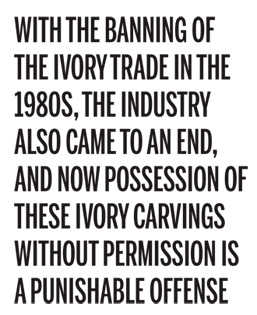
Sri Lanka is a country that has endowed the world with great art for thousands of years.
 Among them, there is much evidence that the art of carving has been popular in the country for centuries.
Among them, there is much evidence that the art of carving has been popular in the country for centuries.
Many types of carvings such as granite carvings, wood carvings and ivory carvings have been popular in the country.
Time
This article is about the history of ivory carvings in Sri Lanka and how it has evolved over time.
The art of ivory carving can be traced back to the earliest times in the world, and a large number of items made using the tusks of the elephant called ‘Mammath’ have been found in caves in Europe and Asia.
Among the ivory artifacts found in countries around the world, especially in Egypt, are ivory combs, hairpins, nude and, other figurines. Ivory carvings was an important form of art in Sri Lanka or Ceylon as it was known earlier. This art is said to have had a certain level of development during the reign of Anuradhapura, the first kingdom of the country.
 Archaeological excavations at the southern entrance of the Ruwanweli Seya in Anuradhapura have uncovered a small ivory figurine of a woman wearing a pearl necklace.
Archaeological excavations at the southern entrance of the Ruwanweli Seya in Anuradhapura have uncovered a small ivory figurine of a woman wearing a pearl necklace.
Archaeologists
This is the oldest ivory creation currently found in Sri Lanka. Archaeologists believe that the carving dates back to the second century CE.
The Mahavamsa also mentions a story of a prince who had excelled in ivory carving and then became a king during the Anuradhapura period.
According to the Mahavamsa, he was king Jettatissa and since he was an expert in the industry, he is said to have set up an academy to teach ivory carving.
He is also believed to have made a living Bodhisattva statue and an ornate pavilion decorated with ivory.
According to the chronicles, the pillars of the Nandana Uyana in Polonnaruwa made by King Maha Parakramabahu were made of ivory and the pillars were decorated with carved boards.
According to the sources, the Nandana Uyana was surrounded by a fence with ivory pillars and similar carvings could be seen in the buildings in the Dupath Uyana built by King Maha Parakramabahu.The literature of the Kotte period also mention ivory designs.
A beautiful ivory carved box gifted to Portugal by a king during the reign of Kotte around 1540 is now on display in a German museum. Its ivory carvings can be seen and are also inlaid with sapphires, rubies and gold.
A small ivory carved scale belongs to the Seethawaka Kingdom period is now on display at the Colombo National Museum and is believed to date back to the reign of Seethawaka Rajasinghe.
Scholars believe that the scales hold a beautiful, delicate writing pattern and that the designer made it with restraint.
The ivory carving industry in Sri Lanka saw great progress during the Kandyan period.
It is evident from the fact that a large number of ivory designs have been made on the advice of King Keerthi Sri Rajasinghe.
The largest ivory structure made during his reign is a door frame of the Ridee Vihara in Kurunegala in the North Western Province.
This is considered to be the largest ivory artifact in Sri Lanka at present and the Panchanari Ghataya is a type of carving that showcases the creativity of Sinhala engravers.
Pattern
It also depicts an excellent evolution of the local decoration pattern.
The most common ivory carvings of the Kandyan period are the Buddha statues and most of them are in a standing position.
Accordingly, the largest Buddha statue made of ivory in the country is placed at the Asgiriya Wijayasundarama Rajamaha Vihara in Kandy.
During the Kandyan period, ivory designs such as Buddha statues, god statues, caskets, combs, knife handles, earrings and human figures have been made.
Palmyrah fans were made using ivory for the bhikkhus and such a Palmyrah fan which is believed to have been offered to Ven.
Weliwita Saranankara Thera by King Keerthi Sri Rajasinghe, can now be seen at the museum located in the Malwathu Maha Vihara in Kandy.
With the arrival of the Europeans, the items they needed were also made of ivory, such as rings, necklaces and various other items.
Icons made of ivory during that period can also be seen. The Europeans created a market for ivory artifacts and during that period the industry spread to Southern Ceylon as well.
Craftsman
Don Juan Wimalasurendra, an ivory craftsman who lived in Galle, has made an ivory coconut flower which is said to be similar in all respects to a natural coconut flower. He then presented it to Queen Victoria, who was pleased and gave him a Mudaliyar post. With the banning of the ivory trade in the 1980s, the industry also came to an end, and now possession of these ivory carvings without permission is a punishable offense.
As a result, these carvings are often found only in temples and museums.
The Hunupitiya Gangaramaya in Colombo has a collection of precious ivory carvings and they can also be seen at the Colombo National Museum, the Kandy National Museum and the Museum at the Temple of the Tooth.
